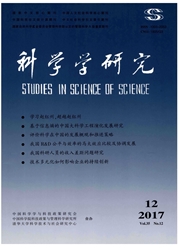

 中文摘要:
中文摘要:
区域间的知识流动逐步发展成为在空间层面上配置创新资源、推进国家创新一体化的重要支撑。利用2008-2014年城市间专利权转移的来源地-目的地"流数据",避免专利引文研究的文献分析缺陷,应用空间交互模型,在区域层面上把单一地理邻近性扩展为包含技术总体水平邻近、技术结构类别邻近和制度邻近的复合邻近性,对城市个体虚拟变量进行回归参数估计,计算得到中国大城市的区域吸收能力水平。实证结果表明,1000-1500公里之间存在着我国知识流动中空间相互作用的临界点,技术邻近性在总体水平和结构类别两个维度上对知识流动的促进作用得到验证,高吸收能力城市呈现出圈带状集聚的空间特征。
 英文摘要:
英文摘要:
Knowledge flow between regions has gradually become the pillar of allocation of innovative resource in spatial and promotion of national integrative innovation. Using the"flowing"date of the transformation of patent rights between the cities as origins and destinations since 2008,the shortcomings of document analysis in patent citation studies are avoided. Applying a spatial interaction model and extending the sole geographic proximity to multi-proximities which contain technological proximity in overall level and structural category and institutional proximity,the cities individual dummy variables are estimated to describe the regional capacities in China's major cities. As the empirical result shows,there is a critical point between 1000 to 1500 kilometers in the interactive effects in China's knowledge flow,and technological proximity is confirmed in 2 aspects. Meantime,the cities with higher regional absorptive capacities spatially appear to cluster to be circles or belts.
 同期刊论文项目
同期刊论文项目
 同项目期刊论文
同项目期刊论文
 期刊信息
期刊信息
